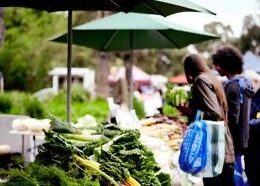Resource
How to give interviews to media
A big part of community food enterprises is telling the story of your organisation or product. This resource helps you prepare for a media interview so you’re comfortable and manage to convey the message you think is most important.
Take control of the process
If you’re not used to interviews you might feel like you need to do what the journalist or cameraperson asks. But you don’t have to! The first step for controlling the message you’re putting out is to line up an interview that suits you.
If a journalist calls, be aware that they may be on a tight timeline, and may want to start the interview immediately. Whereas you will probably benefit from some preparation time. It’s ok to get all the details about what they want to talk about, and arrange to phone them back a short time later once you’ve had time to collect your thoughts. Don’t let it slip into an interview if you would prefer to have some preparation time – you can be firm about this. Sometimes people want to ask for a copy of all the questions beforehand, but it’s unlikely that a journalist will provide this. But you can still get a good sense of what the interview will be about.
Ask the journalist:
- Their name
- What media outlet they’re working for
- What specific show/section they are doing this piece for
- What their angle is for this story
- What they want to ask you about
- Whether they are going to want photos, television footage, etc.
- What their deadline is
It can be a good idea to repeat it back to them, paraphrasing their words, e.g. ‘If I’ve understood, you’re doing a story about farmers’ markets from a farmer perspective, and you want to ask me about how long I’ve been doing markets for, how I prepare for the markets, and how that’s different to selling to wholesale markets. You would like to interview me by phone in the next hour, and to send a photographer to take some pictures of me on my farm before 5pm. Is that correct?’ Then set up the time for the interview that you feel comfortable with. If it’s for radio or television you will want somewhere quiet.
You may have a sense of whether it’s a positive interview or an antagonistic one. If it’s antagonistic, don’t feel obliged to do it, although it can be helpful to clarify a misrepresentation in the media.
If it’s positive, you can also suggest extra points they might like to cover, e.g. ‘It might also be interesting to talk about how selling through farmers’ markets has changed what we produce on the farm.’
How to prepare for an interview
Think about the message that you would most like to convey about your enterprise, and about the topic. Make sure that you don’t miss a good opportunity to market your own enterprise!
Think about what your key messages are. Practice saying your answers out loud. You may find that some phrases get you tongue-tied, so it’s best to think of new, more simple ways to make your point. It may help to write some answers down and repeat them a few times, particularly if you’re nervous.
Making your answers as concise as possible makes them more likely to be used as a quote, so try to write down one sentence that really gets your point across for each of your key messages.
If you are being recorded, photographed or videoed, think about where you would like that to happen. Have a couple of suggestions ready if a photographer or cameraperson is coming out. They may have set ideas about how they want to portray you, but remember that you’re in control.
Try to make whatever you’re wearing simple so that people don’t get distracted by anything, and can just listen to your message. If you’re being interviewed outside choose somewhere that you don’t need to squint or wear sunglasses.
How to stay calm during the interview, and some useful phrases
First, the cautionary side of things: everything you say to a journalist can be used as a quote, unless you explicitly say that you are going off the record. All side conversations as you walk to where the interview will happen, any jokes made off-air – all of them could get used.
That said, often it’s a positive experience! Remember that journalists want a good clean quote or shot for television as much as you want to give it. If you know that you’ve been unclear, take a breath, and then try to make your point clearly like you practiced.
If it’s an interview on-camera, you can even ask the interviewer beforehand that they’re happy for you to pause and try a answering a second time to give a clearer quote. Often they’re happy to do that, particularly if it’s a positive story.
If you’re being asked questions that you don’t know the answer to, you don’t have to try to come up with an answer. Instead, use a ‘bridging phrase’ to take the interview back to the topic you are comfortable discussing.
If the journalist is pursuing a line of questioning that is inflammatory or negative, avoid repeating their phrasing back to them. For example, to the question ‘Are you a crook?’ a simple answer of ‘No, I’m not’ is not very memorable or quote-worthy. Compare that to answering ‘I am not a crook’ which could go down as your most famous line ever (if you’re Richard Nixon). Again, use a ‘bridging phrase’ to move the conversation on.
Examples of bridging phrases are:
- What I’m really focused on is…
- No I’m not saying that. What I’m saying is…
- No that’s not the issue. The issue is…
- I can’t speak for that person, what I can say is that from my perspective…
- I don’t have information on that but what I can tell you is…
- I’m not familiar with that incident, but in my experience…
After the interview
Make sure you get as many contact details as possible from any of the journalists, producers, etc. that you dealt with – you never know when you might want to try to get a story out in the future!
Find out all the details about how you can get a copy of the story so that you can share it on social media, your website, etc.
Where to get more advice
Do you have questions about this topic? Or advice to share? Check out this thread on the Australian Fair Food Forum to continue the discussion.

Latest Resources
Can we help?
Have an idea, a project or a question? Want help using the Open Food Network software? Get in touch and find out how we can help you with it.

Secure and trusted.
Open Food Network uses SSL encryption (2048 bit RSA) everywhere to keep your shopping and payment information private. Our servers do not store your credit card details and payments are processed by PCI-compliant services.
Keep in touch
Join us
Create a listing, shop or group directory on the Open Food Network. Tell me more!

Read our Terms and conditions | Find us on GitHub
Open Food Network is a free and open source software platform. Our content is licensed with CC BY-SA 3.0 and our code with AGPL 3.
We take good care of your data. See our cookies policy




